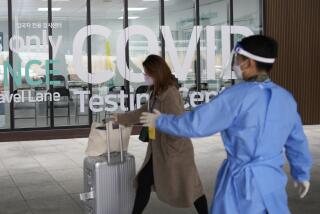S. Korea Upgraded on Japan Travel List
- Share via
TOKYO — In a rather unusual television commercial, South Korean President Kim Dae Jung bids a warm welcome to Japanese tourists, inviting them to “come take a look at the new Korea.”
And the Japanese are responding in droves. Close and comparatively cheap by Tokyo standards, South Korea is emerging as the new destination for recessionary Japan.
Flights from Tokyo to Seoul are so full that it’s difficult to get reservations even weeks ahead of time. One businessman in Tokyo made 25 bookings in the hope of securing two confirmed weekend visits to see his Korean girlfriend during the next three months. “Wait-listed” was the best status he was able to get for most bookings.
Seoul has so many Japanese visitors--buying leather handbags, getting spa treatments and salivating over cheap prices on prized matsutake mushrooms--it’s easy to get the superficial impression that Seoul’s economy is booming, rather than wilting as economic statistics indicate.
Japanese visits to South Korea surged 14% to 1.25 million in the first eight months of this year compared with the same period the previous year. In contrast, traffic to most other destinations--including the United States, Europe and the rest of Asia--sunk about 7% amid a dismal Japanese economy.
Kim’s commercial that urges Japanese to visit at first seems strange: South Koreans have long felt resentment about Japan’s brutal occupation of the Korean peninsula from 1910 to 1945. But attitudes are softening, especially since the Japanese government apologized to Koreans during a recent Kim visit to Japan. Afterward, South Korea lifted its ban on Japanese cultural imports, such as movies and comic books. And recent polls showed that Kim is popular and respected in Japan.
Japanese spending is certainly welcome in South Korea’s ailing economy. The Japanese make up nearly half the country’s tourism trade. A survey taken at the end of 1997 of 495 Japanese tourists showed that each shelled out an average of $1,397, excluding airline tickets. The sum includes $383 for lodging, $240 for dining, $145 for entertainment and a hefty $426 for shopping.
The Japanese tend to buy goods that are far cheaper in South Korea than at home. The biggest spenders at the Dayton Shop in Seoul’s Itaewon area are Japanese, who buy copies of designer-brand goods at less than a third their price in Japan, owner H. C. Shin said.
Meanwhile, amid a stinging recession and a depreciated yen that makes overseas travel far more expensive for Japanese than a few years ago, trips to other destinations have dropped. Travel to the two most popular destinations, the U.S. and Europe, dropped nearly 4% and 2% respectively during the year ending in July, according to the Japan National Tourist Organization, citing the latest figures available.
So instead of heading for Honolulu, many Japanese are scaling vacations back to long weekends, and South Korea is an easy weekend getaway. The toll on the wallet often amounts to less than staying in Japan, where hotels levy a charge for each person, even when rooms are shared. Some tour operators offer three-day trips to Seoul, including lodging and airline tickets, that begin at as little as $250 a person. That’s about the price of a round-trip bullet-train ticket between Tokyo and Kyoto, Japan’s cultural capital.
And because South Korea’s currency, the won, has depreciated substantially against the yen since its own economy collapsed last year, food and lodging cost even less in yen terms.
One big reason for the increase in Japanese visits to Seoul: South Korea has been making a big push to appeal to women travelers by promoting bargain shopping and beauty treatments such as skin rubs and massages.
Whereas fewer than 30% of Japanese tourists a decade ago were women, the figure has increased to more than 40%.
Etsuko Kawase of The Times’ Tokyo Bureau contributed to this report.
More to Read
Sign up for Essential California
The most important California stories and recommendations in your inbox every morning.
You may occasionally receive promotional content from the Los Angeles Times.













